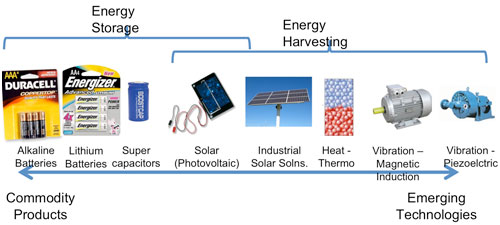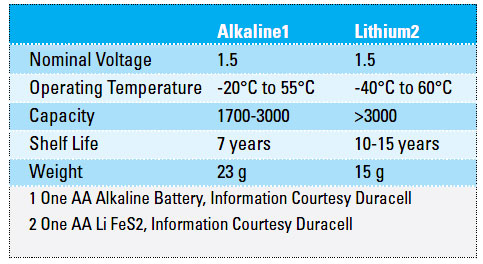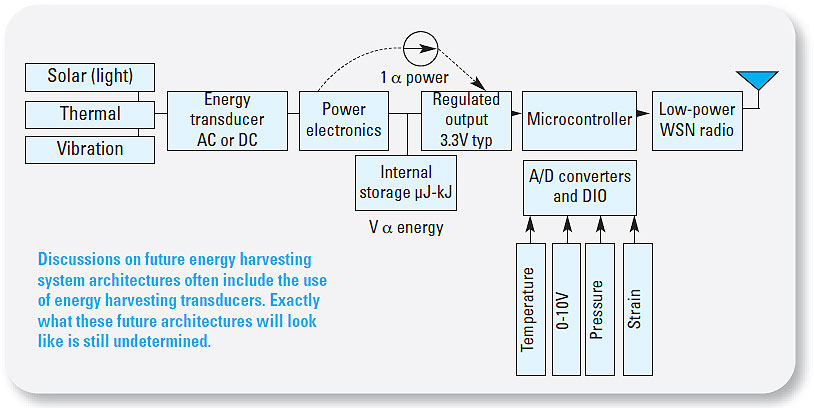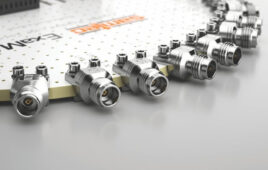By Robert Jackson, Senior Product Manager for Wireless, National Instruments
Without wires, wireless sensor networks do not have a direct means to receive power for operation, so researchers are investigating energy harvesting methods. Here’s a look at this latest method for powering these networks.
The most important feature of Wireless Sensor Networks (WSNs) is the elimination of wires – both communication and power. Without wiring requirements, these networks can be deployed in a range of remote monitoring applications where running wires is prohibitive or impossible. In addition, the removal of wires also reduces the cost per measurement point incurred when adding monitoring functions to existing systems.
WSN systems have varying power needs from a few microwatts of power in sleep mode to a few 100 milliwatts in transmit mode. Thus, these systems require a means to store energy. Wireless protocols and several energy storage technologies are proven and available from multiple vendors, although as with all technology, expect and plan for evolution and change. The scale of technology maturation is broad.

A number of energy storage technologies are proven and available from multiple vendors. However, the scale of technology maturation is broad.
Advantages and disadvantages of batteries
Batteries are the most commonly used energy storage medium for WSNs. They are a mature technology with an easily accessible distribution channel. Power and voltage availability are well defined and the operating temperature ranges are clear.
The two prominent types of commonly available battery technologies are the traditional alkaline battery, available around the world, and in recent years the Lithium Iron Disulfide (Li/FeS2) batteries, which offer the advantages of extended operating temperatures, capacity and shelf life.
With new low-power WSN systems, nodes can operate for up to three years at a 1-minute sample interval on four AA batteries. For certain applications, such as machine condition or structural health monitoring, the goal of continuous power for the operating life of the system has generated significant interest and investment in energy harvesting research.

In discussions of future architectures for WSNs, engineers and researchers bring up energy harvesting transducers. How the transducers and power electronics will be packaged is still unclear. Future architectures often include batteries and other forms of energy storage.
—Supercapacitors. One technology under investigation and used in some early prototypes are supercapacitors, also known as ultracapacitors. Supercapacitors are commonly used in Hybrid Electric Vehicles (HEVs), and store energy by physically separating positive and negative charges – unlike batteries that rely on chemical reactions to separate charges. Supercapacitors store electric charges similar to static electricity with a balloon. Because the process is highly reversible and can be cycled millions of times to extend life, they have the advantages of longevity and quick charge and discharge periods. They currently do not offer the same energy storage density as batteries. Supercapacitors also require additional electronic control and switching circuitry. In future WSN architectures, a supercapacitor might be used for energy storage and connected to specific power electronics. The power could come from multiple sources, each requiring a unique transducer to provide a power source for WSN nodes.
—Solar energy harvesting. As an energy source for WSNs, solar panels are the most mature technology and are supported by a developed market. Complete systems with solar panels, inverters, batteries, and mechanical enclosures are available from several vendors including SunWize, Mr. Solar and Powerup, to list a few. Stores including Lowe’s and Home Depot also provide solar panels for outdoor lighting and other applications that can be converted for use with WSN systems. The factors to consider when selecting a solar panel include:
Solar radiation or insulation of installed location: typically specified using zones that correspond to the average solar intensity of a region. The highest solar intensity zones are closest to the equator.
Voltage range of a WSN – typically 12 or 24 V are available from solar vendors
Daily load requirements – measured in Amp/Hours/Day
Inverter requirements
Mechanical enclosure and mounting accessories
—Thermoelectric energy harvesting. Another potential energy source is derived from thermal differences in the environment. Thermoelectric generators (TEGs) convert temperature differences across dissimilar materials into an electrical potential or voltage. Based on the Seebeck Effect, the voltage generated is directly proportional to the number of leg pairs (N) times the Seebeck coefficient (α), times the temperature difference (ΔT) between hot and cold side.
Voltage = N x α x ΔT

By depositing metals with low thermal conductivity like Bismuth (Bi2Te3) onto the silicon substrate of silicon wafers a TEG can extract potential energy from large differences in temperature. According to data from Micropelt, a supplier of TEG based energy harvesting technology, this type of technology can generate ~ 0.5 mW with a temperature difference of 10° K up to 1.5 mW with a temperature difference of 20° K.
—Vibration energy harvesting. This method can use one of two types of technologies: electromagnetic induction where energy is harvested from the magnetic field produced within an ac inductive motor and piezoelectric energy harvesting from mechanical vibration.
Electromagnetic induction—Energy is harvested from the metal windings within the rotor and stator of ac inductive motors. The actual transducer is a magnetized mass of several grams connected to a specifically designed and tuned spring. This spring is tuned to harvest energy from the resonate frequency produced from ac current. In the US, line voltage alternates at 60 Hz producing a resonance frequency at 120 Hz. In Europe, where the line supply is 50 Hz, the frequency of interest is 100 Hz. An example of this technique is the PMG energy harvester from Perpetuum. According to data from Perpetuum a 450 gm device can produce at least 0.3 mW on most ac motors and when tuned properly can reach a maximum of 50 mW.
Piezoelectric energy harvesting—Energy is harvested from mechanical vibration using the piezoelectric effect, which converts mechanical strain from a vibrating mass into electrical current. This strain can come from different sources, including low-frequency seismic vibrations, acoustic noise and, most commonly, vibration from rotating equipment.
One viable application is generating power from large rotating equipment. When the piezoelectric energy harvester is tuned to the appropriate resonance frequency of a specific vibration source, power in the mW range is possible. Data provided by AdaptivEnergy with their JouleThief technology shows that a range of 0.05 to 0.15 mW is possible with vibration in the 0.025 to 0.075 g, m/s2. These results are encouraging. Technology should continue to improve the efficiency of energy harvesting techniques
The promise grows
Harvesting energy from the environment offers an exciting promise for long-term WSN deployments. Different sources of energy suit specific areas of applications. For example, solar harvesters suit outdoor remote applications where sunlight is readily available. Vibration energy harvesting technology works well in industrial settings with large ac motor drives and other rotating equipment.
If you want to deploy WSN systems today, the best approach is to select hardware and software platforms from established measurement and automation vendors. They have the software architectures to abstract changes in networking protocols and the hardware product roadmaps to adopt the most compelling new power management and energy harvesting technologies – whether from batteries or a combination of emerging energy harvesting and storage technologies.
The range of wireless sensor network applications
Some of the newer applications include:
— Environmental monitoring to model climate change. WSNs are used to monitor carbon dioxide (CO2)
absorption in rain forests. Rain forests serve a vital role for the environment by absorbing CO2 and producing oxygen. For environmental engineers, though, it is impractical to run wiring to remote locations around the world. Wireless measurements help these experts collect the measurement data necessary to develop climate change models. To learn more visit www.ni.com, to read a white paper on wireless environmental monitoring (http://zone.ni.com/devzone/cda/tut/p/id/7395).
— Environmental monitoring to reduce noise pollution in metropolitan areas. Authorities in Mexico City are
monitoring and recording the noise levels in different parts of the central historical district using LabVIEW
graphical software and measurement hardware with a distributed WSN system. They selected a wireless
topology because of lower cost and installation flexibility. The government of Mexico plans to use the acquired data to identify the worst times and locations for noise, create noise maps, and develop and implement regulatory actions to control and promote a healthier “noise” environment with the goal of bringing the noise level in the city up-to-par with other large cities around the world. To read more about the application visit www.ni.com and view the case study: Performing Wireless Environmental Noise Monitoring in Mexico City Using NI LabVIEW (http://sine.ni.com/cs/app/doc/p/id/cs-12371)
— Structural monitoring of civil infrastructure. Recent tragedies such as the bridge collapse in Minneapolis have made it clear that monitoring our aging civil infrastructure is critical to gather the information needed to repair or replace infrastructure before it fails. The National Institute of Standards and Technology (NIST) awarded a multimillion-dollar grant to The University of Texas at Austin in 2008 to conduct a five-year research project to develop a system for monitoring bridge safety in the United States. Identified as a technology partner, National Instruments (NI) design engineers began working with these university engineers on researching and developing the data acquisition hardware and software for the wireless networks and energy harvesting. The implementation of a new wireless, real-time bridge monitoring system such as this has the potential to prevent tragic bridge collapses and save thousands of lives.
— WSNs let you have more measurement points, inexpensively, which lets you collect more data. Will this data spur innovation in existing applications such as asset monitoring and machine condition monitoring? One early example is a parking lot monitoring system at The University of California Los Angeles (UCLA). Imagine if finding a parking spot were as simple as accessing an application on your smart phone that guides you to the closest garage with parking spots available. One of the enabling technologies for this vision is to have hundreds or even thousands of wireless sensors monitoring the parking availability. Although some parking garages include wired monitoring systems, WSNs reduce wiring costs and simplify installations in existing parking garages. This application might not be available from iTunes today, however engineers at the Center for Embedded Networked Sensing (CENS) are taking the first step. Learn how engineers used National Instruments WSNs to monitor the occupancy of the parking garage (http://sine.ni.com/cs/app/doc/p/id/cs-12135) that supports the UCLA Ronald Reagan Medical Center (http://www.uclahealth.org/homepage_med.cfm?id=264), a new hospital on the UCLA campus.
Discuss this on the Engineering Exchange:
National Instruments
www.ni.com
Robert Jackson is a Senior Industrial and Embedded Product Marketing Manager for National Instruments. His current projects include product management for HMIs, Wireless and Energy. Jackson joined NI in July 2002 and holds a B.S. in chemical engineering from Oklahoma State University.
::Design World::
Filed Under: CONNECTIVITY • fieldbuses • networks, Wireless • 5G and more, Energy management + harvesting, SENSORS





Tell Us What You Think!